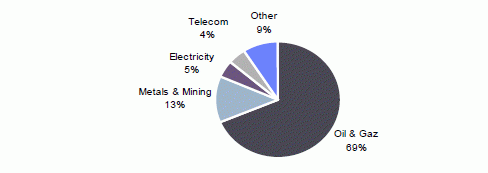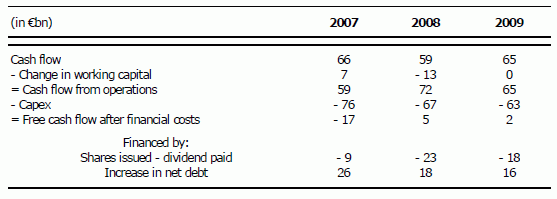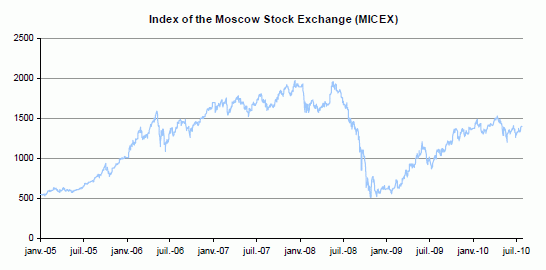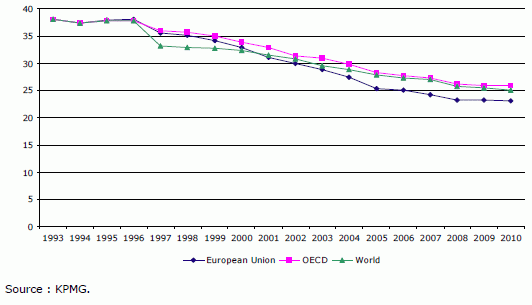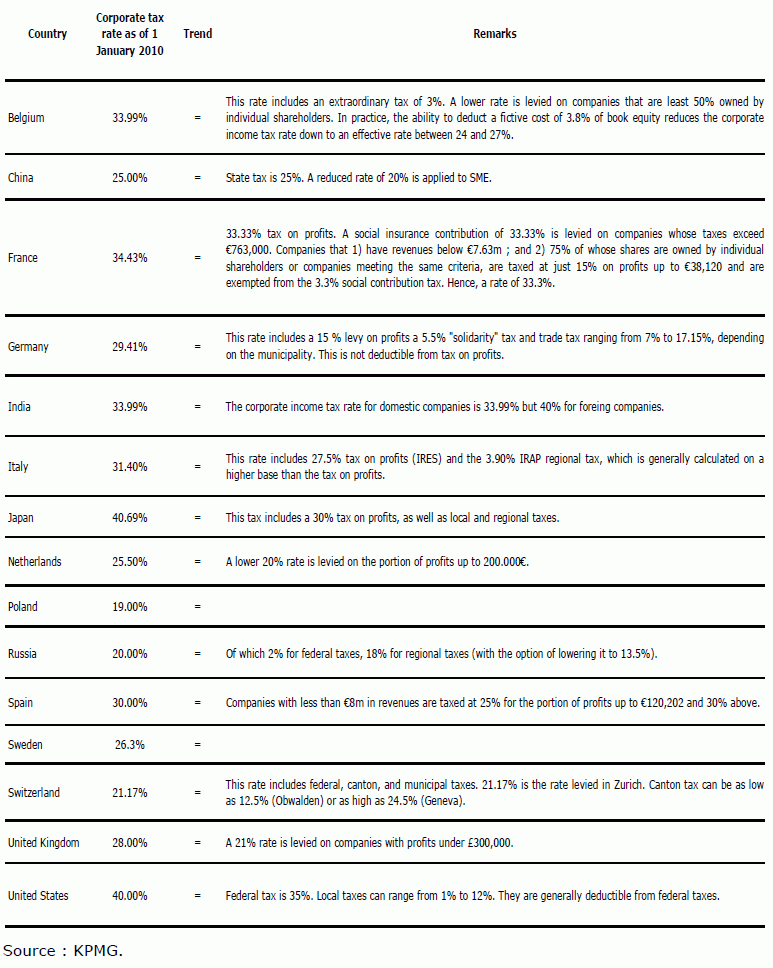Letter number 54 of November 2010
ALL ARTICLES
- TOPIC
- STATISTICS
- RESEARCH
- QUESTIONS & COMMENTS
News : Financial analysis of Russian groups
In December 2009, 234 firms were listed on the main Moscow stock exchange (MICEX). If we eliminate firms operating in the financial sector, firms that have filed accounts for less than four years and very small firms, we are left with 100 firms that account for 72% of the Muscovite market capitalisation (with is around €510bn, or 37% of the market capitalisation of Euronext Paris or about the same as that of Johannesburg).
We analysed these companies using the standard financial analysis method (1). Any readers wanting to consult their cumulated accounts can request copies via the letter box on www.vernimmen.com. Most of them end their financial year on December 31.
Wealth creation
The combined sales of the firms in the sample is €312bn, or the equivalent of the sales of BP.
There is a very large gap between the biggest and the smallest listed Russian companies. The top twenty per cent account for 87% of sales and 97% of EBIT with average sales of €13.6bn and average EBIT of €2.8bn.
On the other hand, the bottom 20% account for 0.2% of sales and -3% of EBIT with average sales of €30m.
Concentration is high, since the biggest 3 groups, Gazprom, Lukoil et Rosneft, account for 50% of total sales, much higher than in China (2) , en India (3) or Brazil (4).
Energy and minerals account for 87% of sales, with other sectors accounting for 9% and telecoms 4%. And who says Russia doesn’t have a raw materials backed economy!
More evidence for this is in the evolution of cumulated sales:
+ 21% in 2007,
+ 34% in 2008,
but -10% in 2009, mainly as a result of the way oil prices behaved. And this at a time when inflation of retail prices has been between 9 and 13% / year since 2006.
All in all, real growth is close to zero and margins, which were very high to start out with, are falling sharply:
For comparative purposes, in 2009, the operating margins of European groups were around 11,6%, or two-thirds those of Russian groups.
Capital expenditure
Management of capital employed shows a net decline in 2009:
Unsurprisingly, given the evolution of sales due to the fluctuations price of raw materials over the period ; sales only rose by 46% for a doubling of net capex.
The sales / operating assets ratios of around 0.8 show high capital intensity, which is double that of the Indian economy, for example.
Capital expenditure represents on average 2.5 times depreciation and amortisation, which is evidence of a degree of investment that should be appreciated in view of inflation, which is running at around 10%/year. Accordingly, the amount booked under depreciation and amortisation underestimates the amount of capital expenditure required for maintaining the industrial facilities in good working order.
Working capital requirement, which represents around 10% of capital employed vs 90% for fixed assets, is stable in days of sales and at a level that is quite normal:
Financing
The large margins generated generally enable Russian groups to self-finance practically all of their investments, and free cash flows after financial expense are more or less nil:
The increase in banking and financial debt over the period remains reasonable, on average, and in 2009 represents 1.2 x EBITDA, vs 1.6 x for European groups. But we know that an average can hide extremes (Rusal for example).
Profitability
Given an inflation rate of around 10% over the period, the profitability generated by Russian groups is, on the whole, mediocre: between 10 and 15% after tax for ROCE and 13 to 23% after tax for ROE which benefits from the leverage effect of the debt.
In 2009, ROCE (10%) is lower than the cost of capital (11%), which explains why the equity capital of Russian groups are only valued at 113% of their book value (5). This is a long way off the situations in Brazil (4 x) or China (3 x). At 8.5 x 2009 net earnings, the levels of valuation of shares apparently take into account the expectation that margins will continue to fall, a corporate governance that could be improved, and a political risk that is specific to certain emerging countries.
But we cannot say that Russian companies are clearly overvalued.
Our thanks to Moad Aberkane for his assistance with data compilation.
(1) See chapter 8 of the Vernimmen.
(2) For more details see Vernimmen.com Newsletter n° 29, December 2007.
(3) For more details see Vernimmen. com Newsletter n° 40, March 2009.
(4) For more details see Vernimmen. com Newsletter n° 52, September 2010.
(5) For more information, see chapter 31 of the Vernimmen.
Statistics : Corporate income tax rates
For the second year in a row, corporate income tax rates have stabilized at around 25% and a bit less in the European Union (23.04% due to new members). The United Kingdom has announced a yearly decrease in its corporate income tax rate from 28% in 2010 to 24% in 2014. Will it act as a bellwether?
Research : Renegotiation of financial contracts
Over 90% of long-term credit agreements between banks and firms are renegotiated before the end of their terms. Items as important as the amount, the interest rate or the term of the agreements may be renegotiated. Although theoretical studies on the financing of firms often take loan renegotiations into account, very few empirical studies have been carried out to date that describe the phenomenon. This month, we look at one such study (1).
The analysis covers a sample of 1,000 credit agreements between financial institutions and US listed firms, between 1996 and 2005. It reveals that long-term agreements (term of over three years) are almost systematically (96%) renegotiated, whether the renegotiation concerns the amount, the term or the interest rate. The extent of the renegotiation is significant – the term is modified by an average of 64% (up or down), the amount by 43% and the spread by 40%. There is, however, very rarely a change in the lender (only 11% of cases).
Renegotiation takes place relatively early on in the life of the agreement, generally before mid-term. It means that the two parties to the agreement obtain a renegotiating surplus. The way this surplus is split depends on each party’s negotiating power.
Renegotiation, which is often initiated by the borrower, can be explained by a change in the latter's financial health. An increase in the value of borrower’s assets and a reduction in the latter’s rate of indebtedness, unsurprisingly results in an increase in the nominal of the loan and a reduction in the interest rate. Similarly, an improvement in the borrower’s investment prospects (2) will result in renegotiations that are particularly favourable to the latter (increase of nominal and/or decrease in interest rates), given its negotiating power.
External factors may also impact on the renegotiation. This is the case, for example, of growth of GDP. When GDP rises, the amounts lent are renegotiated upwards (we say that the renegotiation is pro-cyclical).
Finally, Roberts and Sufi show that the features of the initial agreement influence the way it is renegotiated. If interest paid by the borrower is contractually linked to the firm’s cash flows (we talk about a pricing grid), then a decline in these flows will give the lender greater negotiating powers. The bank offers a reduction in the nominal and an increase in interest rates, which the borrower accepts, as the amount of interest becomes too high.
In the absence of a pricing grid, it would not be in the borrower’s interests to renegotiate a credit agreement when the firm's situation deteriorates, as the initial terms and conditions of the agreement will be more favourable than those that the borrower might expect to get. In this situation, it is the borrower who has the negotiating power.
More generally, when an interest rate on a loan is linked to a variable, any sharp change in this variable is likely to trigger a renegotiation. This result is interesting – when credit agreements link interest rates to a variable, they do not prevent renegotiation, but they set the scene for any renegotiation that does take place.
This article is important as it confirms that a comprehensive theory on financial contracts should never ignore renegotiation. Renegotiation applies to the vast majority of contracts, most often impacts on key items, and is very extensive. Since the vast majority of credit agreements are renegotiated, the main function of the initial negotiation (and the terms and conditions of the agreement) is to divide the negotiating power between the borrower and the lender.
(1) M.R. ROBERTS and A.SUFI (2009), Renegociation of financial contracts: Evidence from private credit agreements, Journal of Financial Economics, n°93, p.159-184.
(2) Measured by the market-to-book ratio.
Q&A : Banking business lines
Most large banking groups now split their activities into the following segments:
Retail banking, which is aimed at private individuals and generally at small- and medium-sized enterprises (SMEs). Retail banks serve as intermediaries between those who have surplus funds, from whom they collect resources, and those who require financing, to whom they lend. They have millions of clients and accordingly, are extremely large. The larger their portfolios, the lower the risk they carry, thanks once again to the law of large numbers. Not all borrowers will default at the same time (even though sheep-like behaviour and excessive competition resulted in some banks forgetting of the main principles of risk analysis in 2006-2007).
Retail banks have developed ancillary services to boost the added value they offer to their corporate customers. Accordingly, they offer a variety of means of payment (cheques, transfers, etc.) to help companies move funds efficiently from one place to another, and they help them manage their cash flow. Finally, retail banks also house a full range of specialised financial services for private individuals (consumer credit, etc.). Specialised financial services for companies (factoring, leasing, etc.) are generally included in this business line as they are clearly aimed at SMEs.
Corporate and investment banking, which provides sophisticated, partially or fully tailor-made services to large corporations. A corporate and investment banking division will have a few thousand clients at the most. It mainly offers the following services:
• access to the equity capital markets: investment banks help companies prepare and carry out initial public offerings on the stock market, and later on, raise additional funds through capital increases. They also advise companies on the issuance of instruments that may one day become shares of stock, such as warrants and convertible bonds (1);
• access to the debt capital markets: similarly, investment banks help large- and medium-sized companies raise funds directly from investors through the issuance of bonds (1);
• merger and acquisition advisory services: these investment banking services are not directly linked to corporate financing or the capital markets, although a public issue of bonds or shares often accompanies an acquisition;
• access to bank financing: syndicated loans, bilateral credit lines, structured financing, etc;
• hedging of financial risks and management of foreign exchange operations.
The asset management division has its own clients – institutional investors, high net worth individuals – but also works for retail banking clients through the provision of unit trusts and mutual funds. It may also offer investment banking products such as hedging, order execution, etc.
Alongside global banking groups that operate in all of the banking business lines, some players have chosen to specialise in a limited number of activities, such as M&A and asset management (Lazard, Rothschild) or in more targeted geographies (Mediobanca in Italy, VTB in Russia).
(1) For more, see chapter 30 of the Vernimmen.
